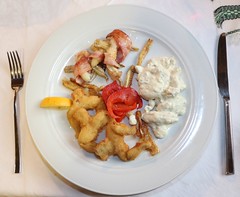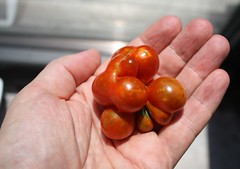Nothing reeks of modernity quite like processed snacks. We cheat nature by mixing the right chemicals into foodstuff (and taking the right elements out) to award it a shelf life of over a year. Even longer. A miracle of science! Except for the diabetes part.
Not to be left out of gastro-scientific advancement, the Philippines offers an MSG-laced bounty of choices to the junk food connoisseur. During a recent visit to a Filipino grocery store in Woodside, Queens, I rounded up a sample of the country’s most recent offerings to taste technology at work.

Everybody knows that the most important part of junk food is the packaging. Especially when I keep looking at it to figure out what the design supposed to mean. Such was the case with Ding Dong mixed nuts. Not sure what the elf hiding under a mushroom has to do with a clanging noise. Or with nuts. But the elf does look like he’s got his finger in his pointy ear.
“Cracker nuts, crunchy beans, peanuts, cornick & tasty green peas,” read the tagline. Cornick is a combination of the words corn and garlic, a much easier combination than using corn and monosodium glutamate.
Perhaps this salty, crunchy snack pays homage to America, the original inventor of junk food, because the dried peas, according to the back of the packaging, are of American origin. Those peas went halfway around the world and came back in a bag bearing an illustration of an elf plugging his ear. Ding Dong: the new sound of globalization.

The first thing I noticed about Snacku vegetable flavored rice crackers is the bag covered with bounty of vegetables, all surrounding–no, festooning–a farmland scene. Then I noticed that according to the ingredients, the snack is free of all vegetables, excepting a cryptic “vegetable flavor” listing. The Filipino junk food industry seems to be beating America at its own game!

Inside the bag were puffy, fry-like things that bore the color of Play-Doh and tasted sweet with a vague flavor of onion powder. Would make good snack after a late-night drinking expedition.

Don’t let the Japanese characters on the bag fool you. Nagaraya products are about as Japanese as Old El Paso molded taco shells are Mexican. Let’s build up that foreign mystique.
Cracker nuts (peanuts coated with wheat flour) already made an appearance inside the bag of Ding Dong mixed nuts. But on the back of the bag of Nagaraya abobo cracker nuts, the company claims to offer a “healthy crunch” despite the high salt content and MSG. Compared to vegetable flavoring, I suppose they have a point.
Adobo is a Filipino dish containing stewed chicken or pork, but you won’t find any meat here. The cracker nuts don’t even taste like meat. But they are surprisingly addictive. Just don’t check your blood pressure after a bagful.

Despite its name sounding like that of a jungle spirit who must be appeased with offerings of gold and virgins, gelatinous mutant coconut is a common ingredient in Filipino desserts. It’s a coconut containing a mutation that keeps its milk and pulp from separating. Apparently, the Filipinos have been cultivating this freak of nature long before America started blowing up Pacific atolls. Or maybe ancient Filipinos were blowing up atolls long before the arrival of Europeans, but never went bragging about it.
The sweet and slightly sour flavor of condensed milk dominated Lucia’s Pastillas de Ube Macapuno, and offered a chewy contrast to the crunchy snacks above. After eating gelatinous mutant coconut, I wonder if I have gained special digestive powers. They could come in handy when confronted with the average half-cooked, rubber-cheese slice of New York City pizza.







